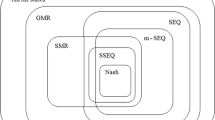Abstract
A new approach to policy analysis is formulated within the framework of the graph model for conflict resolution. A policy is defined as a plan of action for a decision maker (DM) that specifies the DM’s intended action starting at every possible state in a graph model of a conflict. Given a profile of policies, a Policy Stable State (PSS) is a state that no DM moves away from (according to its policy), and such that no DM would prefer to change its policy given the policies of the other DMs. The profile of policies associated to a PSS is called a Policy Equilibrium. Properties of PSSs are developed, and a refinement is suggested that restricts DMs to policies that are credible in that they are in the DM’s immediate interest. Relationships with existing stability definitions in the graph model for conflict resolution are then explored.
Similar content being viewed by others
References
Bloomberg News Series (2004), North Korean nuclear talks are ‘alive,’ Powell says, September 24, 2004.
S.J. Brams (1994) Theory of Moves Cambridge University Press Cambridge, U.K
S.J. Brams D.M. Kilgour (1998) ArticleTitleBackward induction is not robust: the parity problem and the uncertainty problem Theory and Decision 45 IssueID3 263–289 Occurrence Handle10.1023/A:1005038921033
L. Fang K.W. Hipel D.M. Kilgour (1993) Interactive Decision Making: The Graph Model for Conflict Resolution Wiley New York
Fraser N.M., Hipel K.W. (1984), Conflict Analysis—Models and Resolutions. North-Holland, Amsterdam.
J. Hamilton S. Slutsky (1993) ArticleTitleEndogenizing the order of moves in matrix games Theory and Decision 34 IssueID1 47–62 Occurrence Handle10.1007/BF01076104
N. Howard (1971) Paradoxes of Rationality: Theory of Metagames and Political Behavior MIT Press Cambridge, MA
D.M. Kilgour (1984) ArticleTitleEquilibria for far-sighted players Theory and Decision 16 135–157 Occurrence Handle10.1007/BF00125875
D.M. Kilgour L. Fang K.W. Hipel (1990) ArticleTitleA decision support system for the graph model of conflicts Theory and Decision 28 IssueID3 289–311 Occurrence Handle10.1007/BF00162702 Occurrence HandleMR1059707
D.M. Kilgour F.C. Zagare (1987) ArticleTitleHolding power in sequential games International Interactions 13 IssueID2 91–114
F. Nash J. (1950) ArticleTitleEquilibrium point in n-person games Proceedings of National Academy of Sciences of the U.S.A. 36 48–49
J. Neuman Particlevon O. Morgenstern (1953) Theory of Games and Economic Behavior Princeton University Press Princeton, NJ
F.C. Zagare (1984) ArticleTitleLimited-move equilibria in 2 × 2 games Theory and Decision 16 IssueID1 1–19 Occurrence Handle10.1007/BF00141672
Author information
Authors and Affiliations
Corresponding author
Rights and permissions
About this article
Cite this article
Zeng, DZ., Fang, L., Hipel, K.W. et al. Policy Stable States in the Graph Model for Conflict Resolution. Theor Decis 57, 345–365 (2004). https://doi.org/10.1007/s11238-005-2459-x
Published:
Issue Date:
DOI: https://doi.org/10.1007/s11238-005-2459-x




